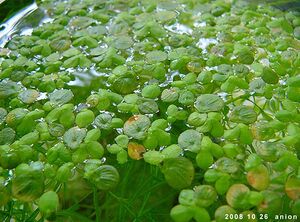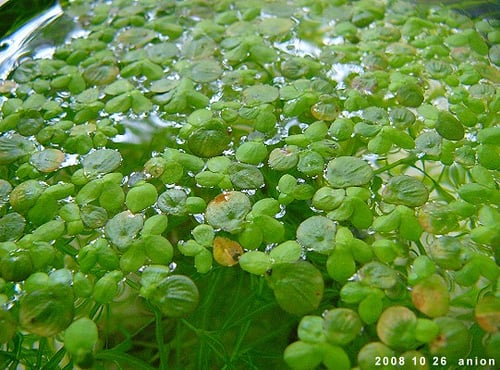참고: 이 페이지는 Open Source Ecology 에서 번역되었습니다 . Appropedia에 적응할 수 있도록 도와주세요.
개구리밥 양식 생산
Lemnaceae (개구리밥, 물 렌즈콩) 가족은 가장 작은 꽃 피는 식물입니다. 그들은 1~3개의 잎과 각 잎에서 하나의 뿌리(또는 뿌리털)를 가진 자유롭게 떠 다니는 식물입니다. 매우 빠른 성장으로 인해 개구리밥은 공격적인 연못 침입자가 될 수 있으며 종종 골칫거리로 간주됩니다. 파도의 영향을 받지 않는 조용한 물에서 빽빽한 군체를 이루며 자랍니다. 인과 질소 함량이 높은 영양분이 풍부한 물이 필요하기 때문에 농업 유출수 지역에서 자주 발견됩니다. 다양한 종이 알려져 있으며 전 세계적으로 다양한 기후에서 자랍니다. 표면적당 생산성이 매우 높기 때문에 개구리밥은 미래 지구촌에 큰 잠재력을 가지고 있습니다. 이 작은 수생 식물은 오염을 정화하고 지구 온난화를 방지하며 전 세계를 먹여 살릴 수 있는 엄청난 잠재력을 가지고 있습니다.
개구리밥 - 오리만을 위한 것이 아닙니다: 열대 생태 농장, 농업 및 임업 대학 -CAF, Thu Duc, 베트남 호치민시 연구:
"개구리밥은 아마도 가장 빨리 자라는 다세포 식물일 것입니다. 그것은 폐수에서 자연적으로 자라며 24시간 안에 무게가 두 배가 될 수 있습니다. 그것은 단백질 함량이 그것이 있는 물의 질소 함량에 따라 조작될 수 있다는 점에서 식물들 사이에서 독특합니다. 이것은 생물 소화기와 통합되기 때문에 중요합니다. 생물 소화기에서 나오는 폐수의 질소를 사용하여 단백질 함량을 약간 낮은 수준으로 강화할 수 있기 때문에 통합 농업 시스템에 도입하기에 이상적인 수생 식물입니다. 콩보다 35%에 가깝습니다 단백질 생산 측면에서 이상적인 조건에서 재배하면 연간 헥타르당 10톤의 단백질을 생산할 수 있습니다. 이는 연간 1톤 미만을 생산하는 콩과 비교됩니다.
개구리밥은 인공비료가 필요 없기 때문에 환경에 좋고, 반대로 유기물 분해에서 나오는 유기질소와 무기질소를 제거해 폐기물을 정화해 부영양화에 기여한다. 살균제가 필요하지 않으며 심각한 자연 해충이 없습니다.
개구리밥은 닭, 오리, 돼지가 먹을 수 있으며 현지 적응 품종에 필요한 모든 단백질을 공급할 수 있습니다."
특정 용도
음식으로 개구리밥
품종과 성장 조건에 따라 개구리밥은 건조 질량의 최대 50%에 이르는 매우 높은 단백질 함량을 가질 수 있습니다. 높은 수준의 비타민도 함유되어 있습니다. 맛은 시금치와 원격으로 비슷합니다. 개구리밥은 역사적으로 일부 동아시아 요리( Wolffia 속)에서 중요한 역할을 했습니다. 빠른 성장과 재배의 용이성으로 인해 동물과 인간이 소비하는 개구리밥은 이제 더 많은 관심을 받고 있습니다. 현재 동물 사료로 사용되는 용도는 대부분 어류(잉어, 틸라피아) 및 조류 사료(닭, 오리)입니다. 인간 식단의 일부로 가능한 용도는 아직 많이 연구되지 않았습니다.
바이오 에너지를 위한 개구리밥
Duckweed는 다른 꽃 피는 식물보다 빠르게 바이오 매스를 생산합니다. 그것은 바이오 연료 생산을 위한 대안으로서 분명한 잠재력을 가지고 있습니다.
바이오 센서로서의 Duckweed
개구리밥은 중금속 및 유기 오염 물질을 탐지하는 데 사용됩니다. 그런 다음 성장 속도, 잎 크기 및 색상, 뿌리 크기 등 다양한 매개변수를 측정하여 식물의 건강을 평가할 수 있습니다.
오염물질 제거용 개구리밥
Duckweed는 물 청소에 매우 효율적입니다. 먼저 모든 다량 영양소를 제거합니다. 그러면 미량 영양소가 제거됩니다. 마지막으로 독성 물질과 방사성 물질을 포함한 모든 금속 이온을 제거합니다. 따라서 산업 폐수 '광택', 하수 전처리, 다른 양식 활동 및 기타 질소 배수 상황(축적장 등)에서 배출되는 폐수를 탈질화하는 데 사용할 수 있습니다. 개구리밥 양식에 관한 아래 기사는 이 주제를 다루고 있으며, 과잉 축적자로서 개구리밥에 대한 더 많은 학술 연구가 곧 나올 것이라는 데 의심의 여지가 없습니다.
생물채광용 개구리밥
Duckweeds는 질소와 인산염의 우수한 농축기입니다. 그들은 미네랄을 용액에서 미량 농도로 끌어내는 능력을 감안할 때 생물 채광 에 사용될 수 있습니다 . 수확된 개구리밥은 동물성 식품, 바이오가스 소화기 등을 포함할 수 있는 영양 순환에 들어갈 수 있습니다. 이렇게 하면 일반적으로 인이 부족한 토양이 있는 지역에서도 흙탕물에서 인 및 기타 영양분이 생물학적으로 축적될 수 있습니다. 그러나 이것은 아직 아이디어 단계에 있으며 바람직하지 않은 생체 축적(예: 알루미늄) 문제를 해결해야 합니다.
도전
개구리밥의 전체 층은 연못의 더 깊은 수준에서 대부분의 햇빛을 차단합니다. 따라서 녹조가 제거됩니다. 이는 원하는 효과입니다. 그러나 더 깊은 수준에서 햇빛이 부족하면 산소 부족 상태로 이어질 수도 있습니다. 결과적으로 혐기성 박테리아가 증식하여 식물을 인간의 식품으로 부적합하게 만들 수 있습니다. 그런 다음 에어스톤과 같은 폭기 장치가 필요할 수 있습니다. 개구리밥은 매우 조용한 물에서 가장 잘 자라기 때문에 표면을 휘젓지 않는 것이 중요합니다.
아이디어와 응용
인간의 소비 :
- 샐러드 또는 수프, 샌드위치 또는 야채 스프레드의 구성 요소로 개구리밥
- 대용품: 상추, 시금치, 물냉이, ...?)
동물용 :
- 생선(예: 틸라피아), 닭, 돼지,
새로운 균주
[여기에 삽입: 특정 용도에 최적화된 새로운 품종에 대한 정보, 더 높은 수확량, 더 많은 지질, 다른 맛, 더 특정한 생체 축적 등].
개구리밥 게놈은 2009년 말까지 완전히 시퀀싱 될 것으로 예상됩니다 . 이것은 개구리밥 생물학에 대한 우리의 이해를 크게 향상시킬 것이며 이러한 식물에 대한 유전 연구를 가속화할 것입니다.
연결
크로스, JW (2006). Duckweed의 매력. [1]
일반적으로 개구리밥 과 Wolffia 에 대한 Wikipedia 항목
2008년 7월 Treehugger 기사 [2]
개구리밥 양식업에 대한 매우 포괄적인 매뉴얼 [3]
양식업을 위한 주요 공급 원료로서의 개구리밥 [4]
가축용 사료 보충제로서의 개구리밥 [5]
식용 개구리밥에 대한 자세한 내용이 있는 이전 특허 [6]
통합 틸라피아 및 개구리밥 재배 시스템 [7]
개구리밥 생산을 위한 생물분해 폐수 및 연못 사용 매뉴얼(베트남산) [8]

